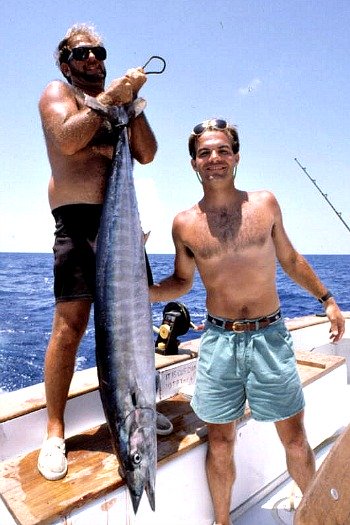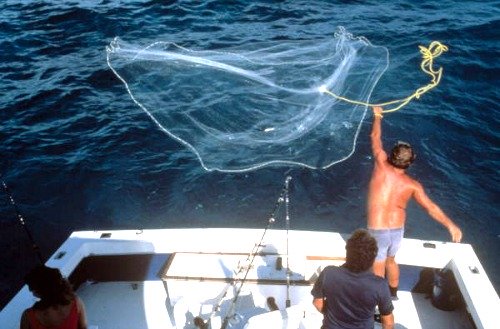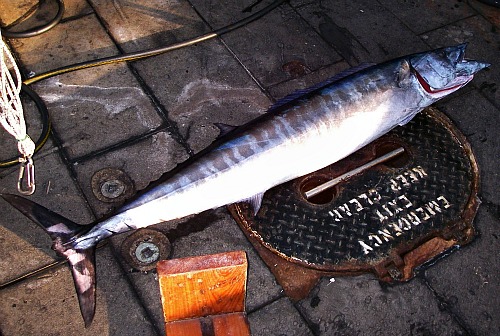Looking For Something Florida Keys Related?
Search here for what you want (ads also appear)
Search here for what you want (ads also appear)
How To Catch Wahoo Fish Easier
And Safer With These Fishing Tips
When sport fishing Florida Keys, wahoo fish aren't always the first fish that jumps to mind - but they should be.
This is also one the fastest Florida Keys fish and is renowned for ripping off line and making the drag on your reel smoke.
Inhabiting temperate waters, the wee-hoos, or juveniles are often found congregated near structure in small to mid-size schools.
It was believed that adults were more solitary and traveled alone or in limited numbers, but they actually are in schools and when you catch one, you can typically back track to get more.
When deep sea fishing Florida Keys waters, nothing compares to the excitement of seeing a wahoo chase your bait at almost blinding speed. With speeds of 60 - 70 miles per hour, these fish race under and around your boat, making it almost impossible to follow their movement with the naked eye.

Wahoo Caught Florida Keys Fishing
State Archives of Florida, Florida Memory, Dale M. McDonald Collection
State Archives of Florida, Florida Memory, Dale M. McDonald Collection
It obviously takes serious skill and fishing equipment to find, and successfully reel in one of these lightning fast torpedoes.
As an Amazon Associate I earn from qualifying purchases such as these items above and further below.
Going it alone, without having the right equipment or know how, are often the biggest mistakes fishermen make when planning a wahoo fishing trip.
You'll find your level of success and enjoyment increases significantly when you go out with a fishing charter that specializes in targeting wahoo and other deep sea fighters.
As A FishingBooker Affiliate I Can Earn Small
Booking Commissions At No Extra Cost To You
Planning A Wahoo Fishing Trip?
Best Florida Keys
Wahoo Fishing Charters!

Planning A Wahoo Fishing Trip?
Best Florida Keys
Wahoo Fishing Charters!

Wahoo Fish Facts
In the Florida Keys, this species has been found in the Atlantic Ocean and the Gulf of Mexico. They've been spotted several miles from shore and 50 miles out over the ledge. They've been seen lying motionless over structure in large groups as shallow as 100 feet depth, and they've been caught when specifically targeting other species of fish such as tuna and dorado.
When targeting these dynamos, certain factors such as whether it's windy or calm aren't important. However water temperature has some determination, and in the cooler winter months they're usually found further from shore in deeper water.
Averaging between 15 and 50 pounds, this long, slender bodied fish can attain weights of 100 pounds or more. According to the International Game Fish Association, the largest hooked wahoo on record weighed in at a whopping 158.5 pounds.
Widely considered to be one of the most striking fish in terms of appearance, this Florida Keys fish has a deep blue shading along the top. This color fades down the sides, with the belly being a silvery sheen, and the sides beautifully trimmed with lighter blue vertical 'racing' stripes.
As one of the fastest pelagic Florida Keys fish, this species is undoubtedly one of the more formidable fighters to catch. Not only does wahoo speed affect a sport fishing enthusiasts ability to catch one, the unique quality of their mouth and jaw compounds the problem.
Wahoo fish have a soft mouth which can easily be torn, plus their jaw has the ability to move up and down and side to side. This makes it possible for this sport fish to work the hook loose and make a lightning fast getaway. This is one of the reasons why it's critical to keep a super tight line at all times when one is hooked.
Like the barracuda, this fish has razor shark teeth, although they are smaller in size when compared to a 'cuda. They will often bite the prey just before the tail to disable it, and then slice and dice as they swim through the bait fish. They eat a variety of fish including sardines, mackerel and squid, and are often caught between 100 and 300 feet of water.
With lightning speed they run down their prey and they've been seen jumping high into the air after bait fish desperately trying to escape the slick torpedo racing after them.
Unlike sailfish, dorado, and some of the other popular pelagic species, they are not normally aerial fighters when caught.
Instead, their modus operandi is to make a fast run or two ripping off several hundred yards of line. They'll then turn, making a complete 180 and race back at the boat, shaking their heads violently in an attempt to work the hook loose.
Wahoo Fishing In Florida Keys
Courtesy of Youtube and fishing2009ful
Courtesy of Youtube and fishing2009ful
The formidable teeth of the wahoo fish are also the focal point of a fisherman's nightmare. Many anglers have been severely injured or maimed because of these razor sharp teeth, which represent a serious hazard to anyone or anything near them.
Fingers and hands have been sliced off, serious cuts have been inflicted, and if the fish targets your bait or lure as you're bringing it out of the water, they can jump up after it, biting and maiming the anglers in the boat.
When wahoo fishing, it's important that safe measures be practiced. Keep the boat moving slightly so the lines stay tight. Make sure you bring the fish up to the side of the boat, not the back, and have the ship's mate or a fellow angler grab the gaff and hook the wahoo.
Carefully grab the long wire leader keeping the line tight, so it doesn't work loose and injure those on board. Work quickly to get the struggling bullet up and into the fish box and don't remove the hook until the fish is dead.
This is also one of the tastier, mild flavored fish even though they are in the mackerel family. Avid chefs will have no problem finding a variety of tempting wahoo fish recipes, but wahoo fish tacos are perhaps one of the more popular, common wahoo recipes.
Even though wahoo fish are considered one of the better eating, the Florida Department of Health has issued a mercury warning for those caught in the Florida Keys and Florida Bay.
One unpleasant predilection of this species is that they are prone to having the giant stomach worm. As unappealing as this discovery may be to someone cleaning the fish, it poses no hazard to humans when cooking wahoo.
If you're planning a Florida Keys fishing vacation and are intent on experiencing the thrill of fishing for this species, wahoo season is best from November through to August, with the later summer months usually producing multiple catches at one time.
How To Fish For Wahoo
When targeting this species there are a variety of wahoo fishing techniques that can be employed, and unlike catching other species, often the methods that work best seem to contradict each other.
Fishing over structure and where there's color change are important. The time of day and fishing where the bait fish are plentiful are also other constants. Two other equally successful strategies when wahoo fishing are direct opposites of each other - use more speed vs jigging and drifting.
Wahoo Fishing Techniques - Structure and Light
Whether wahoo fishing the ledge 50 miles offshore, or hovering and trolling over reefs and wrecks, you'll have more success catching this Florida Keys fish over structure, then aimlessly wandering the ocean.
Perhaps it's the ambush nature of the wahoo that causes them to seek out the benefits structures offer, but if you're serious about wahoo fishing, this is what to look for.
Light is another constant factor, and the dimmer it is, the better. This proclivity may be due to their preference for ambushing prey.
If you're Florida Keys sport fishing, the best times for this species are from dawn to early morning, and then again late afternoon to near sunset, especially on an outgoing tide. Due to their preference for lower light conditions, night fishing is becoming quite popular with anyone serious about catching wahoo fish.
Trolling For Wahoo
Wahoo trolling speed is also an important factor in how successful you'll be. Trolling for wahoo at speeds of 10 - 20 knots or more, has proven to be very productive. Partially because you can cover more territory, and perhaps because it entices these high speed predators. It also means anglers have to use heavier wahoo fishing tackle.
Trolling with plugs and wahoo fishing lures is a wahoo fishing technique proven to be very effective for anyone sport fishing Florida Keys. Unlike live or dead bait, lures can withstand the force of the water at these higher wahoo trolling speeds.
The lures are also equally good for catching other large species such as marlin and tuna, so when purchasing the lures you know you'll have diversity in what you'll be able to catch.
Plugs and heavy cigar sinkers set a few yards in front of the wire leader get the lines down deeper so they stay below the wake. The motion of the wahoo trolling lures helps to draw the much deeper fish up and into attack mode.
Many anglers opt to use a combination of lines running at different lengths and depths. Using a downrigger and a planer you can space your lines out at various distances from the boat. On one side of your boat, you can extend lines out from 150 feet to 350 feet.
On the other side of the boat you can stagger the lines, offsetting them from the other side of the boat so they run out at lengths of from 200 feet - 450 feet.
Typically your shortest lines will run at the deepest depths, and your longest running lines will be staggered at shallower depths. However, by using 100 pound braided line you'll be able to increase your line depth even more.
You can increase your success by using a combination of lures, or use live bait with a 5/0 hook in the mouth and a #2 treble hook near the end of the bait. Secure this with wahoo teeth proof heavy #19 wire or #30 titanium leader which is less visible than wire and doesn't kink or break. Then use a swivel to attach this leader to a heavy shock leader and the line.
To bring the lines deep you'll stagger them with a combination of weights ranging from 48 ounces to 16 ounces using the heavier weights on your short lines and working back out to your longer lines.
Once you're rigged up, you then move your boat in a straight line, high speed trolling for wahoo at 14 - 20 knots. By making zig zag turns as you go, you'll help drop the lines and wahoo fishing lures to their different depths over the structure.
The key to your success is keep your lines taut at all times, set the drag heavy enough so you can set the hook, but keep the drag light enough so it's still possible to maintain your wahoo trolling speed.
Trolling With Wahoo Bait
You can also use dead or live bait fish such as pilchard, ballyhoo and mullet, and then your wahoo trolling speed will be between 8 - 12 knots. If you're using live bait, the faster you go, the harder it will be to keep the wahoo bait alive.

Casting For Wahoo Baitfish
State Archives of Florida, Florida Memory, Dale M. McDonald Collection
State Archives of Florida, Florida Memory, Dale M. McDonald Collection
With live bait you'll spread out your lines at different distances using a combination of lighter weights so the bait fish can swim just below the surface. You'll also want to add on heavier weight to your shorter lines so some bait fish can go deeper giving you the opportunity to target wahoo at different levels.
However, it's becoming more established that it's not necessary to go wahoo fishing using live bait. The combination of speed and wahoo lures or plugs seems to be more effective and is certainly more hassle free.
Jigging and Drifting and Slow Trolling
High speed trolling for wahoo is very effective, but the opposite strategy also works well. Jigging is one popular way for anyone to target this Florida Keys sport fish. Hovering near flotsam or over structure, use heavy wire leaders and a combination of colored jigs. Then drop down to about 80 feet and rapidly pull the line and jig up to entice them into frenzied feeding action.
Another light tackle fishing approach is where you use multiple lines on a downrigger. In this scenario you would slowly move over the structure to keep your lines from tangling.
Rigging up you'd use 50 pound test, a sinker to drop deeper, an 8 foot long monofilament shock leader with a 2 - 3 foot #6 wire leader or titanium leader to protect the line. Use a single hook 6/0 or 7/0 set far back in the live bait where the wahoo will first bite.
You'll also want to use a combination of bait fish such as goggle-eye, sardine, pilchard, mullet, speedos, and herring. You'll maximize your results by stacking 3 different species of bait fish at varying depths of about 100 foot on one downrigger. Once you're done, you just sit back and wait for them to come racing up after your bait.
You can also use a single hook in the mouth and a treble hook further back as a safety precaution, but with the double hooks you'll have to make sure the bait fish swims true before sinking it.
Lures For Wahoo
One of the important aspects of angling for this aggressive species is to use a variety of combinations when
deep sea fishing Florida Keys waters. Different lengths, different depths, different lures and different bait fish. It's the mixing up of the elements that makes wahoo fishing the most productive.
Anglers who prefer high speed trolling for wahoo know however that lures are more hassle free, and work better than bait simply because they withstand the punishment. When choosing the best wahoo lures, you'll need to consider color combinations, weight, flash, even sound, along with your preferred method of fishing for wahoo.
If you're wahoo trolling at higher speeds, any swimming plug works well. Anglers will often use the skirted trolling lures that are popular with so many species of fish. However with their razor sharp teeth, these skirted lures will have a tendency to become quickly shredded.
Blue and white wahoo lures, and black and silver lures are typically very productive. On overcast days black and purple lures work well. Other popular colors combinations are orange and black, chartreuse, black and red, and pink.
By placing one of these lures in front of a horse ballyhoo teaser bait or a spoon or mullet then on different planers, you can adjust your depth. By staggering your combinations, you offer these torpedoes a variety of enticing choices at all depths.

Successful Day Florida Keys Wahoo Fishing
Courtesy of NOAA/NMFS/SEFSC Pascagoula Laboratory;
Collection of Brandi Noble, NOAA/NMFS/SEFSC
Courtesy of NOAA/NMFS/SEFSC Pascagoula Laboratory;
Collection of Brandi Noble, NOAA/NMFS/SEFSC
Wahoo fish are one of the more unusual Florida Keys fish simply because they are always a surprise. Just when you think you have everything all figured out, you don't.
Then when you're angling for other fish, wham you've got one of these torpedoes on the line. When that happens you'll quickly discover you can't help but yell "Wahoo!"
Looking For Something Florida Keys Related?
Search here for what you want (ads also appear)
Search here for what you want (ads also appear)
You May See Ads Here
SAVE BIG WITH THESE
KEY WEST DISCOUNTS
KEY WEST DISCOUNTS
Local Weather Zip Codes
Key Largo - 33037
Marathon - 33050
Key West - 33040
Key Largo - 33037
Marathon - 33050
Key West - 33040
|












Comments!
Do you have anything to add? We look forward to feedback on what you've just read so leave me a comment in the box below.